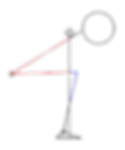Squat Right For Your Body Type--Part 1
- Shay
- Feb 28, 2022
- 3 min read
Updated: Dec 22, 2024
If you've ever spent time in a gym, you've probably heard several bunk dogmas about squats:
You must squat with your feet narrow
Your shins must remain vertical
You must squat ass to grass
Squat in a low bar position to get the most power
The truth is, most of these things should be dictated by the anatomical specifics of an athlete, as well as injury history and current mobility. Anthropometry, or the systematic measurement of the physical properties of the human body, gives us a few insights into what factors matter most when considering the form and loading position of a squat. Let's take a look at some key considerations.
In Part 1 we will be taking about:
Lever Ratios, why they matter, what bar position is best for each, and how to figure out your own
In Part 2 and 3 we will be talking about:
Hip Angles, why they matter, and how to figure out your own
Other postural considerations in the squat
Lever Ratios
When we talk about levers as they pertain to squat anatomy, we are mainly looking at the ratio of the legs to the torso. There are 3 basic body types:
Long legs, short torso
Short legs, long torso
Balanced levers
Keep in mind, a person cannot have long legs AND a long torso. This would simply mean a tall person with balanced levers, as "long" pertains to a comparative ratio.
Let's look at how this pertains to the back angle in a squat.

Squatter 1 will have a much more "pitched forward" squat in order to keep the bar centered over the arch of the foot. If they were to bring their torso to a more vertical position, you can easily see from the diagram below that their center of balance would be too far back, and they would fall backward.
So dispels the myth "You must squat with a vertical torso!

Squatter two is clearly much more vertical than squatter one--though not completely upright!
Because the femur is so much shorter, there is not such a need to "sit back" and this lifter will feel much more natural with a more upright posture.
The bar is still centered above the arch of the foot, but if this lifter were to create a more horizontal line with their torso, they would be more inclined to pitch forward.
Squatter three, the balanced squatter, is a happy medium between lifters one and two. The hip crease is a reasonable 45°, versus the very steep angle in lifter one, and the slightly wider angle in lifter two. This lifter probably has the most versatility in terms of bar position and foot width.

Balanced Levers
Ideal Bar Position
So with all this in mind, which squat is best for each body type?
Long legs, short torso- The low bar squat is likely the best at maximizing your proportions.
Short legs, long torso- The high bar squat will probably feel best, and you're a natural born squatter!
Balanced levers- You should experiment and train both styles regularly to see which one feels more natural. As there is no "perfect" balance, you will also need to figure out which posture feels best with your individual hip angle, etc.
Find Your Own Lever Ratio
Finding your own leg/torso ratio is really easy!
Find a flat object like a book and wedge it between your thighs as high as it will go (higher than the image shows).
Measure (in inches) from the floor up to the very top of the object.
Divide your leg length by your overall height and multiply it by 100 to get a percentage
Look up your percentages using the chart below

| Average | Long | Short |
Torso | 32% | >32% | <32% |
Leg | 39% | >39% | <39% |
Keep in mind, this formula is not going to tell you EXACTLY how upright or leaned forward you should be, but it should give you a much better idea of how to maximize your proportions.
Final Thoughts
With all the above in mind, realize there is no "perfect" back angle out there. It will greatly depend on your lever lengths, along with some other anatomical considerations, which we will discuss in future posts Part 2 and Part 3.
Regardless of what bar position and back angle you squat with, always make sure that your back angle stays consistent with heavier loads, always make sure that your bar is centered above your midfoot, and always make sure that your spine stays in neutral.
Until next post, happy squatting!

